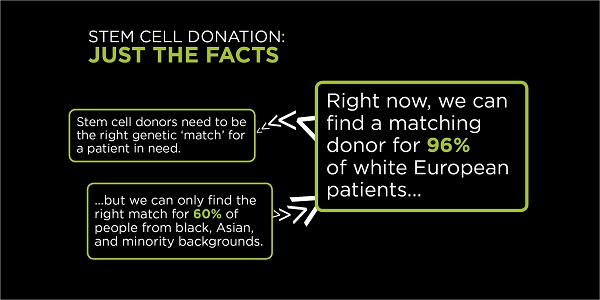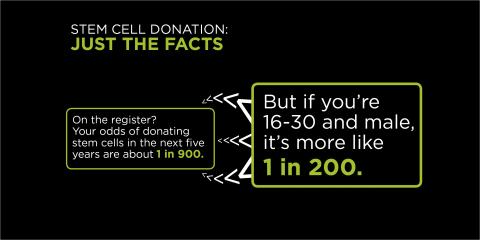At Anthony Nolan, we recruit lifesavers – with a register of more than 550,000 people in the UK, all of them ready and waiting to donate stem cells or bone marrow to a patient in need.
But once you’re on the register, how likely are you to actually donate? In our latest blog, we explain the facts.
If you’re ever chosen to be a stem cell donor, we’ll get in touch, explaining that you’re a ‘match’ – but what does that mean, exactly?
The science of a stem cell transplant
If a patient has blood cancer or a blood disorder, their body will no longer be creating healthy white blood cells (which are vital for your immune system and fighting off infection).
Stem cells, meanwhile, are the ‘builder’ units in your body which create all kinds of other cells, including white blood cells.
That means we can give somebody with blood cancer a ‘fresh’ transfusion of stem cells from a healthy donor, which will then multiply and start making normal white blood cells – and, if effective, will give the patient a whole new immune system.
But there’s a problem.
Your body has defensive systems in place, so it won’t just accept any stem cells.
When stem cell transplantation was still in its infancy back in 1958, medical researchers discovered that immune-system cells contain a very specific string of DNA code called an ‘HLA-protein’.
Your body uses this protein as a kind of identity card; it accepts cells that contain the right HLA type, and attacks cells that don’t.
So every stem cell donor needs to have a similar HLA type to their recipient, in order to ‘trick’ the body into accepting the transplant.

We need to keep recruiting young people as donors for patients in need, both now and in the future – but donors from minority backgrounds are particularly in demand
How Anthony Nolan finds matching stem cell donors
If a patient in the UK needs a stem cell transplant, their doctors will get in touch with us at Anthony Nolan.
They’ll give us the patient’s HLA type, and our scientists will use our advanced matching technology to look for the right donor on all of the UK registers. (And if we can’t find the right donor in the UK, we’ll begin looking abroad.)
Sometimes, we’ll be able to provide them with a number of potential donors to choose from. If the patient has a rarer HLA type – for example, if they’re from an ethnic minority, or they have mixed heritage – we might not have that freedom of choice.
That’s a huge problem. Right now, only 60% of people from black, Asian, or ethnic minority backgrounds can find a suitable stem cell donor, compared to 96% of white European patients.
As a result, we urgently need to recruit more young people with mixed or minority heritage to the register.

Recruiting younger men isn’t just about medical preference – there’s a statistical lack of them on our register, as well.
How likely am I to donate stem cells?
That’s the science of a match – but there are a wide variety of other factors to think about, as well.
In general, doctors prefer younger donors (which is why we have a joining policy at Anthony Nolan to recruit people aged 16–30).
This is partly because they’re less likely to have any health problems which could prevent the transplant from taking place, but it’s also because research suggests that they can often provide better outcomes for patients.
- From 2010-2015, the most common age of any stem cell donor from our register was 23.
For a variety of reasons, doctors are also more likely to choose men to donate than women.
- In the last two years, more than half of our donors were young men – but they only make up 15% of people on the Anthony Nolan register.
- On average, your odds of donating stem cells in the next five years are 1 in 900 (you’ll stay on the register until you turn 60). But if you’re a young man, they’re 1 in 200.
Every stem cell donor matters
Finally, it’s important to note that a huge amount of work and consideration goes into the selection of every single stem cell donor, and there are always a number of complicated medical factors in play.
So if you’re chosen to donate (no matter what your age or gender), it’ll be because the experts know that you can give a patient the best possible chance of life. And that really is incredible!

Want to make sure we can keep recruiting the best donors and conducting lifesaving research? Get in touch today.
